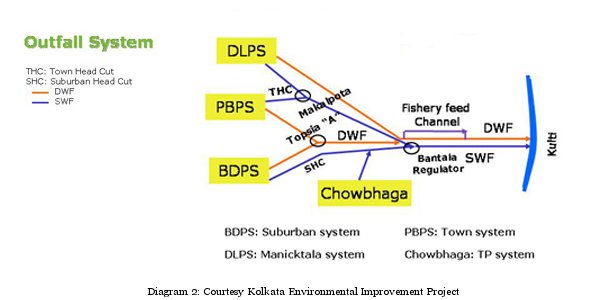A major problem faced by the towns and cities across the world is the dealing with the huge volume of wastewater generated everyday. The wastewater is either treated with high costing conventional water treatment procedures or let untreated into rivers or other water bodies.
Treatment of wastewater is becoming a must with limited fresh water availability and perennially increasing demand. There are very few options of low cost efficient ecological wastewater treatment schemes that recycle the water for other productive uses. The east Kolkata wetland system is one of them. Kolkata is the only metropolitan city in the world where state government has introduced development controls to conserve the wetlands, which doubles up as waste treatment system through recycling process. The wetland is largely manmade, comprising intertidel marshes including salt marshes, salt meadows with significant waste water treatment areas like sewage firms, settling ponds, oxidation basin is one of the rare examples of combination of environmental protection and development management where a complex ecological process has been adopted by the local farmers by mastering the resource recovery activities. It is the largest ensemble of sewage fed fish ponds in the world in one place. East Calcutta Wetlands has been designated as a Ramsar Site in November 2002.
Kolkata is the only metropolitan city in the world where state government has introduced development controls to conserve the wetlands, which doubles up as waste treatment system through recycling process. The wetland is largely manmade, comprising intertidel marshes including salt marshes, salt meadows with significant waste water treatment areas like sewage firms, settling ponds, oxidation basin is one of the rare examples of combination of environmental protection and development management where a complex ecological process has been adopted by the local farmers by mastering the resource recovery activities. It is the largest ensemble of sewage fed fish ponds in the world in one place. East Calcutta Wetlands has been designated as a Ramsar Site in November 2002.
The Kolkata Municipal Corporation area generates roughly 600 million litres of sewage and wastewater everyday and more than 2,500 metric tons of garbage. The wastewater flows through underground sewers to pumping stations in the eastern fringe of the city, and is then pumped into open channels. Thereafter, the sewage and wastewater is drawn into the fisheries of the East Kolkata Wetland by the owners of the fisheries. Here, after a few days, the organic compounds of the sewage and wastewater biodegrade. A network of channels is used to supply untreated sewage and to drain out the spent water (effluent).
The cumulative efficiency of reducing the BOD of the sewage wastewater is above 80% and for coliform bacteria 99.99% on an average. The solar radiation is about 250 langleys a day, and is adequate for photosynthesis. In fact, the sewage fed fishery ponds act as solar reactors. Solar energy is tapped by a dense population of plankton. Plankton are consumed by the fish. Though the plankton plays a significant role in degrading the organic matter, its overgrowth becomes a problem for pond management. It is at this critical phase of the ecological process that the fish play an important role by grazing on the plankton. The two fold role played by the fishes is indeed crucial–they maintain a proper balance of the plankton population in the pond and also convert the available nutrients in the wastewater into readily consumable form (fish) for humans. The fish farmers of East Kolkata Wetlands have developed such a mastery of these resource recovery activities that they are easily growing fish at a yield rate and production cost unmatched by any other fresh water fish ponds of this country. However, this wetland today is facing a number of problems today like encroaching urban development, rapid siltation of water bodies etc. There is an urgent need of a management plan that took proper account of the whole complexity of the system and the livelihoods of the people involved.
Despite the mentioned problems, the east Kolkata wetland remains a shining example of symbiotic man nature interaction. The city of Kolkata gets its huge volumes of daily sewage treated at no expense and gets in addition a substantial daily supply of highly edible freshwater fish. In fact, Kolkata city receives about one third of its daily requirement of fish from the sewage-fed fisheries (about 11,000 metric tonnes annually). The lessons learned here could be of interest to city authorities elsewhere.
To know more about the east Kolkata wetlands refers to the following links:
1.WWF site:
Click here
2.East Kolkota Wetland Management Authority:
Click here
Click here
3.Govt.of.West Bengal, The role of East Kolkota Wetlands:
Click here
4.Microbial genetic resource mapping of East Calcutta wetlands by S. Ray Chaudhuri and A. R. Thakur , CURRENT SCIENCE, VOL. 91, NO. 2, 25 JULY 2006